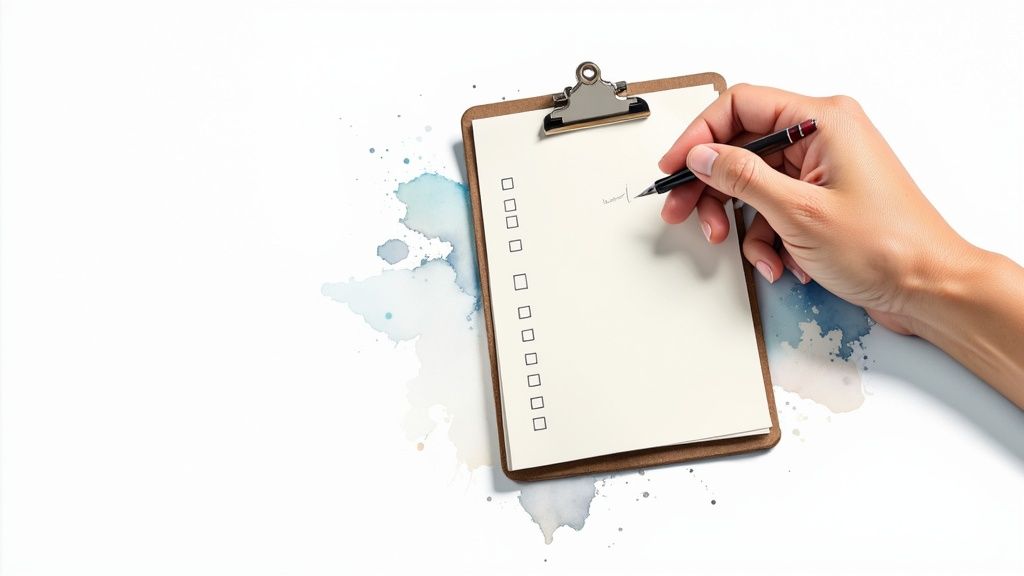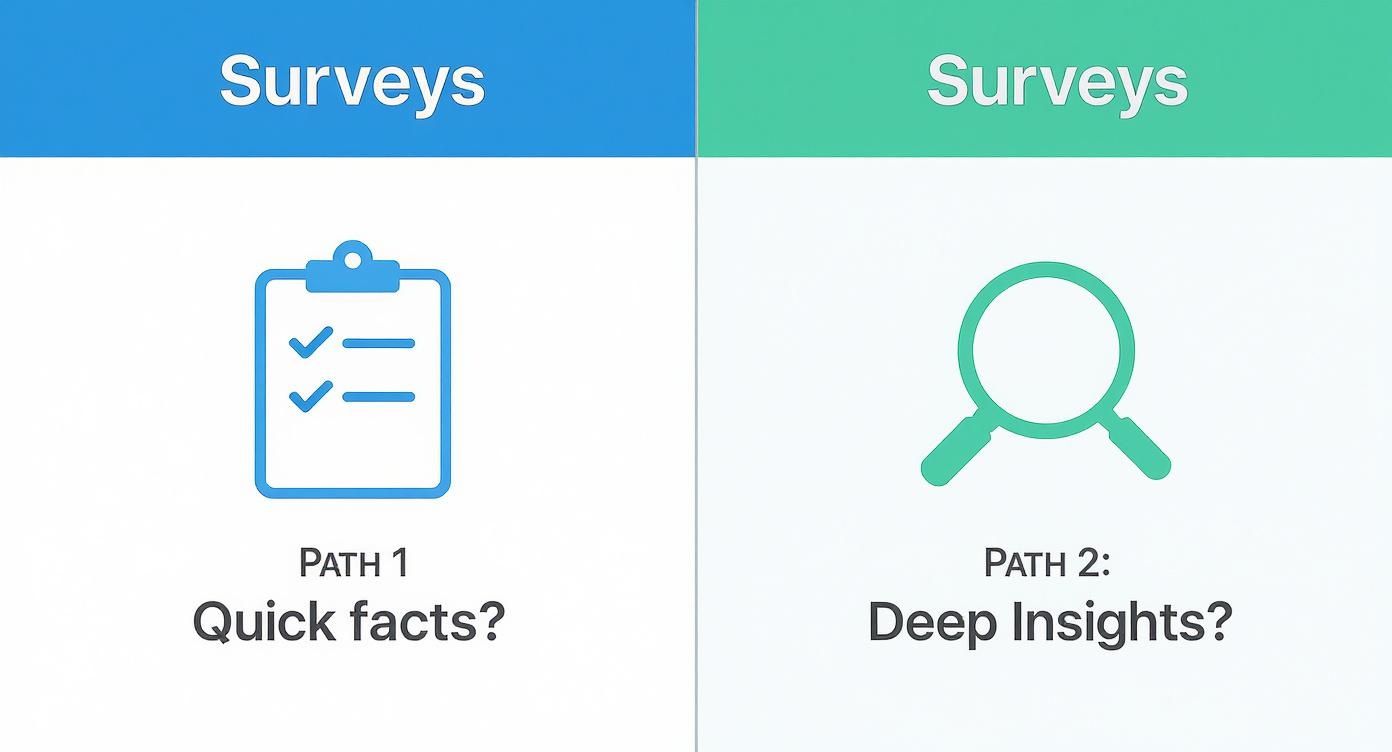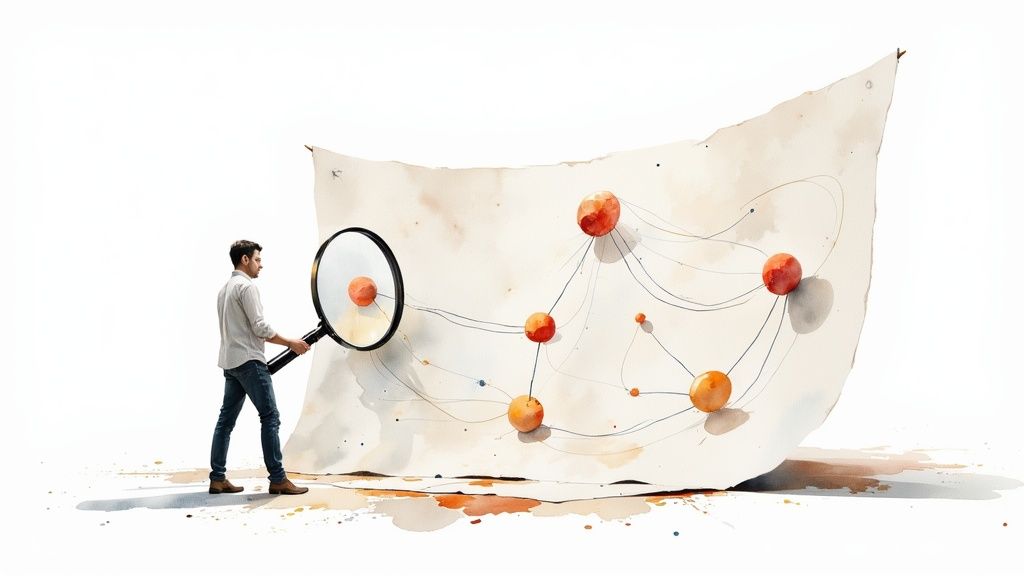Surveys vs. Questionnaires: Stop Confusing The Hammer For The Blueprint
Uncover the difference between surveys and questionnaires, when to use each, and practical tips to improve your research results.
Posted by
Related reading
Customer Advisory Board: The Founder's Playbook for Avoiding Catastrophic Mistakes
A practical guide to building a customer advisory board that provides honest insights, validates your strategy, and prevents costly product mistakes.
Reputation Management Tools: The Secret Weapon Behind Loyal Customers & Higher Revenue
Reputation management tools help you track customer opinions, detect red flags early, and convert negative feedback into retention wins. See how they work & why feedback-driven SaaS like Backsy outperforms survey-only tools.
How to Collect Anonymous User Feedback (With Ready-to-Use Form Example)
Learn how to collect anonymous user feedback with higher honesty and lower bias. Includes examples, templates, and a ready-to-use feedback form you can embed instantly.
Let’s get this straight, because I see founders torching their runway on this mistake all the time: a survey and a questionnaire are not the same goddamn thing. And no, this isn't some nerdy semantic argument. It's the difference between building a product customers fight to buy and building a solution to a problem nobody has.
Confusing them is like thinking a hammer is the same as the architectural blueprint for a house. One is a dumb tool; the other is the strategic plan that keeps the whole thing from collapsing. If your “customer research” is just a list of questions, you’re swinging a hammer in the dark.
The Core Difference: Tool vs. Mission
A questionnaire is a component. A list of questions. Its job is to collect data points, that's it. A survey is the entire goddamn mission. It's the strategy, the audience targeting, the data collection (using your questionnaire), the brutal analysis, and the insight that saves your ass from a bad pivot.
Your competitors who get this aren't just “listening to customers.” They’re running intelligence operations that tell them exactly where to build, who to sell to, and what to charge. They’re not guessing.
Here's the only chart you need on this.
Quick Answer: Questionnaire vs. Survey
Look at this table. One is a simple tool. The other is a strategic process. Don't mix them up.
| Aspect | Questionnaire (The Tool) | Survey (The Strategy) |
|---|---|---|
| Primary Goal | Collect specific, factual data | Analyze data to find a market signal |
| Scope | A standalone set of questions | An entire research process |
| Typical Output | A spreadsheet full of raw answers | An intelligence report with a go/no-go decision |
Takeaway: Get this wrong and you’re just collecting noise, not intelligence.
Understanding Questionnaires: The Raw Data Collector
A questionnaire is a list of questions. Period. Its only job is to gather specific data, fast. Think of it as your blunt instrument for research. It’s not for uncovering deep, existential truths about your customer. It’s for getting facts.
You’re asking things like, "What is your job title?" or "Did you use our new feature this week?" Closed-ended, multiple-choice, yes/no. It’s about speed and scale, not nuance.

This structure makes them cheap and easy to deploy. People can fill them out in 90 seconds while waiting for coffee. Cint’s data shows they can be 30-50% cheaper than deep-dive surveys. But cheap has a price.
Using a questionnaire to understand deep customer pain points is like trying to perform surgery with a sledgehammer. It’s a messy, ineffective way to kill your product.
A questionnaire tells you what people did, not why. It’s great for quantitative data, but it’s blind to motivation. If you must use one, at least make the questions good. Adding a few smart, a strategic guide to open-ended questions can salvage some value, but don't fool yourself into thinking it’s deep research.
Takeaway: A questionnaire is a fast, cheap tool for gathering simple facts, not a crystal ball for user intent.
Decoding Surveys: The Strategic Intelligence Operation
A survey is not a list of questions. It's an intelligence operation. The questionnaire is just one of your assets in the field. The survey is the entire mission: defining the target, choosing the sample, deploying the questions, analyzing the hell out of the responses, and turning raw data into a battlefield map.
This is how you find the signal in the noise. A real survey mixes quantitative data (the "what") with qualitative, open-ended questions (the "why") to give you the full picture. It’s how you spot a competitor’s weakness, validate a seven-figure pivot, or figure out why your churn rate looks like a crime scene. Because it's a full-blown research project, a survey can easily cost 2-3 times more than just firing off a questionnaire. Don't believe me? read more on how surveys are structured.
You wouldn’t go into battle with a rusty knife. Don't go into a strategic decision without the right intel. Check out the best survey tools for a small business to see what a real arsenal looks like.
Takeaway: Your competitors are collecting answers; a survey delivers a strategic roadmap built on evidence.
When to Deploy a Questionnaire for Quick Wins
Use a questionnaire when you need fast, simple, and cheap. Don’t overthink it.
Need to know what t-shirt sizes to order for your team? Questionnaire. Need contact info for a webinar? Questionnaire. A quick pulse check on a feature nobody is screaming about? Fine, questionnaire. It’s for collecting facts, not opinions that matter.
The Litmus Test: Asking 'Why?'
The line between a questionnaire and a survey is one word: Why?
The second you need to understand the motivation behind an answer, you’re in survey territory. The biggest trap founders fall into is using a questionnaire to validate a complex idea. It’s like using a thermometer to diagnose cancer. You’ll get a number, but you’ll have zero context and you'll probably kill the patient.
This isn’t new. The U.S. Census started using this mass-data collection method back in the 1930s to get basic facts, not to understand the nuanced suffering of the Great Depression. The history is clear on this: history of questionnaires in research.
This decision tree should be tattooed on your arm.

It boils down to this: questionnaires are for the "what." Surveys are for the "why." If you're betting your company on the "what" alone, good luck. If you must ask "why," at least learn how to write open-ended questions that don't suck.
Takeaway: Use a questionnaire for logistics and simple facts, not for decisions that could sink your company.
When a Full Survey Is Your Only Path to Victory

Sometimes, a quick-and-dirty questionnaire is just irresponsible. When the stakes are high and being wrong costs you the company, you run a survey. No excuses.
Are you about to pivot the entire product? Trying to understand why your top customers are churning out overnight? These are not moments for a gut check. These are moments for hard evidence.
A real survey digs into customer psychology, maps the competitive terrain, and stress-tests your value prop before you bet the farm on it. This is why governments and massive corporations use them to make policy. They can't afford to be wrong. You can see how these large-scale surveys are built—it's about rigor, not vanity metrics.
If a decision can make or break your next quarter, shipping a questionnaire is malpractice. Run a proper survey and base your move on evidence, not your ego.
Takeaway: High-stakes decisions demand a survey. Anything less is a gamble you can't afford to lose.
Putting It All Together: The Bottom Line
Look, nobody's pinning a medal on your chest for knowing this difference. But your P&L will. Your customers will pay you for it. Get it right, and you navigate the market. Get it wrong, and the market crushes you.
A questionnaire collects dots. A survey connects the dots into a picture that shows you where the treasure is buried.
Too many founders are drowning in disconnected dots, wondering why they can't see the path forward. Stop collecting data for the sake of it. Start running an intelligence operation.
Takeaway: Ignore your customers, and you’ll be lucky to survive the quarter.
Frequently Asked Questions
I get these all the time. Here are the blunt answers.
Can I Just Use a Questionnaire Inside My Survey?
Yes. That’s literally how it’s supposed to work. The survey is the mission. The questionnaire is the tool you use on the mission.
Think of it like this: the survey is the entire bank heist—the plan, the team, the getaway car, the execution. The questionnaire is the crowbar you use to pry open the vault. Essential, but useless without the rest of the plan.
Takeaway: A questionnaire is a component of a survey. One is a part of the other.
What's the Biggest Mistake People Make With This?
Thinking data collection equals insight. I see founders blast a shitty questionnaire to their whole email list, get a flood of useless answers from the wrong people, and call it "customer research."
This is how you end up building features for ghosts. They'll wave around a spreadsheet full of responses as proof they did their homework, but all they really did was collect noise.
Takeaway: Garbage in, garbage out. A bad questionnaire just helps you collect garbage faster.
Is a Twitter Poll a Survey or a Questionnaire?
It's a crappy questionnaire. It’s one question fired at a random, unscientific mob of people scrolling on the toilet.
It’s fine for settling a debate on whether pineapple belongs on pizza. It is not a tool for making a decision that involves real money. If your product roadmap is based on Twitter polls, you deserve to fail.
Takeaway: Using a Twitter poll for market research is like asking a Magic 8-Ball for financial advice.
Stop drowning in feedback spreadsheets and let Backsy show you the revenue hidden in your customer comments. See how to turn raw customer comments into your next winning feature.